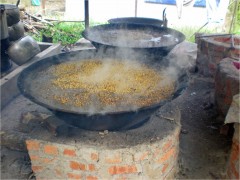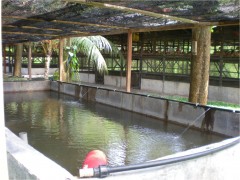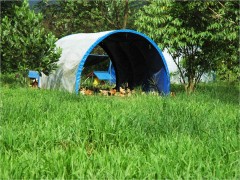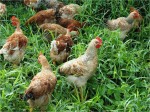Apr 14, 2013
Our Chickens Love Our Fruits As Much As We Do
People ask why we feed our chickens fruits, up to 40% of their diet, and not sell the fruits and use the proceeds to buy cheap grains like corn, since fruits, especially our certified organic fruits fetch such a high price? Well the answer is this: We Are What Our Animals Eat, health-wise that is. Bananas for example have an omega 6: omega 3 ratio of 1:1. Corn is 40:1. Chickens fed corn and other grains will have ratios of 40:1 and more. One chicken we had tested came in at 59:1. That's scary. And what about those chickens fed organic grains? Well, at the risk of sounding flippant, you will end up with 'organic' omega 6.
18:06 | Permalink | Comments (0) | Tags: omega 6 omega 3 ratio in our food, organic chickens, grassfed chickens, malaysia, organic feedstock
Oct 08, 2011
Raising Free Range Chickens - Necropsy & Disease Identification
Being able to perform necropsy of dead chickens and to identify diseases is crucial for the success of a chicken farm.
Delays in disease identification can lead to outbreaks resulting in high mortality and economic losses.
It is absolutely necessary for detail records to be kept from Day 0 until all the chickens are sold, for each batch. Detail records will enable us to analyse out trends and history, which together with the lesions in organs will help identify the many causes of poor weight gain, mortality, etc.
For example, trend analysis enabled us to identify a non-gumboro spiking mortality phenomenon in young chicks below two weeks old, which we ultimately traced to mosquitoes.
Dirgha Bahadur Tamang, from Nepal, has reached competency in necropsy and disease identification.
Dirgha receiving his certificates from Razaly, the farm director
We provide him with a 3 inch thick file of laminated pictures of the key clinical signs of various common chicken diseases. He uses the pictures as a reference and when he sees the start of infectious disease in culled chickens, he will raise the alarm for quick pre-emptive action.
Dirgha with his certificates and his file on common poultry diseases
We hope to be able to sponsor him for further studies to be a vet some time in the future.

Dirgha performing a necropsy on a young chick.
Jan 23, 2009
What do we feed the chickens?
So, what do we feed the chickens? Grass of course. We seeded over 30 varieties of grasses, legumes, and plants in the fields. We selected them for protein, for omega 3 and for antioxidants.
Then, we supplement by cooking for them! Yes, we cook for our chickens to give you the best, most flavorful, nutritious chicken you can find in the world:

These huge cauldrons, or kawahs ("crater kuali") are used to cook for the chickens. What do we cooked? The final mix is a secret, but we have banana piths, old-type non-GMO jagung, ubi, sago and lots of tilapia from our own ponds.

Here's a pond next to the reban to cool down the chickens while trapping the flies and insects as free protein for the fish.
00:33 Posted in Chickens | Permalink | Comments (0) | Tags: grassfed, free range, organic chickens
Permanent Free Range?
What's with our claim that our chickens are "Permanent Free Range"?
In some countries, free range is defined as having "access to outdoors". So, if you have lots of little doors for the chickens to go out, and yet you place all the feeders inside so that the chickens seldom if ever go out, you can still validly say your chickens are free range. In Malaysia, free range can mean hanging around a permanent reban which the chickens retire to during the night. The grounds will be smelly, dirty, full of flies.
Our permanent free range chickens are raised in fresh fields with movable coops being used to move them from padang to padang. They never go back to a reban. They are moved from fresh field to fresh field, and when the time come for them to be harvested, they are on fresh fields, not muddy smelly bacteria infested grounds.
We are the only farmer in the world using these heat-insulated movable, dismantleable field houses. One man can pull the tent to a fresh field once the existing field becomes dirty.


00:13 Posted in Chickens | Permalink | Comments (2) | Tags: grassfed, free range, organic chickens









